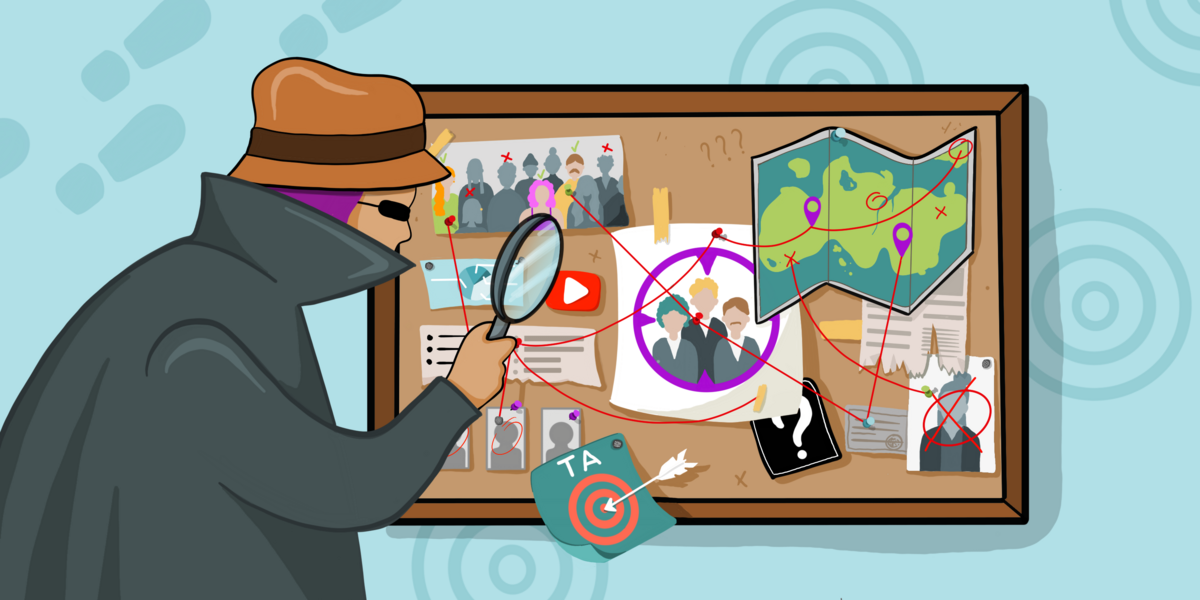Target Audience on YouTube

STOP! Don’t upload that video until you have determined who your target YouTube viewer is.
If you have never thought about it, then you may face challenges while developing your channel. Without a clear understanding of who your target audience will be, your content will be like a ship set sail without direction. Lost.
So let's figure out what the target audience is, how to find them, and why you need one.
In terms of YouTube, the target audience (TA) is a group of people who are interested in your content, your product, and your personality.
It is your content that satisfies their needs. It can be anything like the need to figure out how to renovate your home, or entertainment, and cat videos. It doesn't really matter.
Your target audience is watching you just because you match their request.
When you start a channel and create a content plan which includes scenarios of your videos, you already realize who your content will be targeted for: men or women, children or adults, construction workers, or car fans. It all depends on the purpose of your content and your ability to efficiently analyze content and niches.
Lack of target audience analysis can lead to a low number of views or subscribers, which can result in the failure of your channel or product. Spending too much money on advertising that you target on everyone and at the same time on no one, is also a dead-end case.
It’s not enough to know that you are being watched, for example, by men from 18 to 25. You also need to clearly understand what kind of people they are. Perhaps, they happen to be tech-savvy and watch your channel for the reviews on various repair tools. Or maybe, on the contrary, they are into cinema and filmmaking, because your channel is about how to write scripts and make films.
And yes, in both cases, these are men from 18 to 25, however, you will surely fail to get a tech-savvy audience excited about movie content if that’s not their interest. Therefore, you need to clearly identify what kind of people you are hoping to attract. It’s called building a portrait of your target audience.
A proper understanding of your audience is the key to growing easily and smoothly on YouTube.
Why know your target audience?
- To fight off the competition. If you clearly identify what people want to get from the channel in this or that area and if you analyze what they like and what they dislike, you have a chance to get around even the top channels.
- To cut the costs down. Launching an ad for any YouTuber is exciting and inevitable, so you need to clearly prepare for it in every way.
- To get to know your customer base better if you are selling something. Who will buy your product, at what point in life are they, under what conditions - all this gives a portrait of the target audience.
- To find upside potential. Vlogging has no end goal, we are always in the process of growth and development. If you stop at some point, somebody else who understands his subscribers better will take advantage and outperform you.
Now that we understand how important the Target Audience is, we can dive deeper into this area.
Types of the target audience
There are several types of target audience in modern marketing. We shall analyze those groups that are directly related to sales and apply them to YouTube promotion.
- Direct and indirect
The direct TA makes a purchase decision. It is this type of TA who initiates an action unlike the indirect target audience.
If we apply this to YouTube, where the product is our content, then the indirect type of target audience is the one that watches without a subscription and is not active on the channel. Thus, the direct audience is a subscriber, who hits the like button, and leaves comments. Our task as YouTubers is to attract as much of a direct audience as possible.
- Wide and narrow TA
Let's consider a simple example: a wide audience watches a channel about repairs, and a narrow one watches videos specifically about how to properly assemble a bed.
- Audience by type of target group
In terms of marketing, it sounds like "Target Audience in business (B2B) and focusing on individual consumers (B2C)". What we mean is that our audience can be divided into people who come to the channel privately, and channels for businesses or companies that benefit from our content.
Imagine that there is some kind of abstract crocheting channel. Most viewers come to learn how to crochet for themselves. However, among these viewers, there may be a thread manufacturer who is excited about watching you because you are his potential advertising demographic.
- Audience for the purpose of visiting your website
In our case, it’s not about a site, but about a channel. There are two purposes: buying and searching for information. This is the target audience interested in the channel content: viewers come to get information, while subscribers are interested in goods and services for subsequent purchase. It is relevant for those who make content and at the same time sell something else related to this content.
For example, if you are a major vlogger who talks about your life, and also actively earns on your own merchandise.
So, we have identified the types of target audience. Now, let's learn how to create a portrait of your target audience.
How to create a portrait of the target audience
The target audience can be divided into segments, or it can be divided into individuals. You need to be able to do both if you want to work through your content thoroughly.
A segment is a group of people that fits the description of your target audience. It is determined mainly by common socio-demographic factors:
- gender
- age
- education
- income level
- geographical location
- social and family status
- profession, place of work, type of activity
- nationality or race.
These factors will help you create a portrait of a group of people who are generally interested in your content. Once you make this description of the audience for your channel, you will have taken the first steps forward toward your success.
An example of a portrait of a segment of the target audience: women from 20 to 35 years old, with secondary or incomplete higher education, married housewives with children, living in London and the United Kingdom.
This type of portrait is suitable, for example, for a cooking channel, a parenting channel, or a sewing channel.
However, you can focus on an even more precise portrait of the audience. To do this, there is such a thing as psychographic characteristics. They no longer describe a segment or group, but a specific person that represents your subscribers.
You will need the following points to come up with a description:
- description of personal characteristics (conservative, ambitious, cheerful, innovator, a life of the party, etc.)
- values, life positions, and attitude to important social problems (opinion on the environment, globalization, politics, population living standards)
- interests, hobbies, lifestyle
- behavioral features (is it easy or difficult to motivate this person for something, whether he easily finds a compromise or he likes to argue, etc.)
- what goals does your viewer pursue (this question should be considered through the prism of your topic and niche. If we are talking about construction, what is your users goal? To build a house from scratch, make repairs in an apartment, or just choose wallpapers)
- fears and worries a viewer has in relation to their goals (your subscriber may be afraid to incorrectly calculate the budget for repairs or, for example, get low-quality materials)
- what prevents your viewer from achieving these goals (as an option, the lack of time or contacts of good constructors. Or maybe there is little money for repairs or your potential subscriber cannot come up with a design and because of this, they always put the repair works off)
- how we can help this viewer achieve their goals (we provide information that shares contacts of great formans or describe how to correctly identify a good designer or teach them how to glue wallpaper for further research)
- where and when your videos are watched, at what point in life, and under what circumstances (in a company or alone? Concentrated or with tea? This will give you an understanding of how light or heavy your content should be).
The easiest way is to start with a narrow audience and then expand it gradually. This is when your super targeted audience will begin to pay off for you. New viewers will come to the channel, check out the activity in the comments and this will motivate them to subscribe to the channel. ‘Well’, they will say to themselves, ‘since others love it so much, maybe I will like it too?’
Even the way you communicate with your subscriber on the channel will depend on how well you describe your subscriber. If you are still looking for the focus of your vlog and do not understand how to look for it, then the audience portrait can help you a lot.
Imagine that you are explaining complex topics about chemical elements, but you understand that your target audience is schoolchildren, and among them, there are both A-students and D-students. If the first are interested in information, then the latter are excited in the way the information is given to avoid getting bored and comparing you with their teacher, because if they are not excelling in this subject, the teacher has not found an efficient approach to this particular student. But, if we create an effective portrait of a D-student, we will be able to understand his true goals and motivation, his desires and tastes.
Hopefully at this point, your brain is starting to formulate a bunch of out-of-the-box ideas on how to present information: show chemistry through cartoons, or, for example, deliver information in a Tik Tok style. Or maybe insert some relevant memes into your explanations, because teaching for children who do not want to learn is obviously a pain. Your job is to make learning interesting and fun, and a complex subject simple and understandable.
But all these methods and tricks can only contribute to growth when you truly understand your viewer. What kind of person they are, what they do, and what they love.
Let's move on. Let’s take a look at some tools for determining your target audience.
We can’t just daydream about our target audience and hope Santa Claus will deliver them wrapped in a nice neat box. No, we have tools that will help us determine our audience. Based on analytics and what kind of portrait you have created for your channel, you will be able to clearly understand what content to make, what methods to use, and what jokes or interactive elements to add into your videos. Lastly, you will have a powerful cheat sheet of who to target during any advertising campaigns you use to market your channel.
Tools for searching and decoding your target audience
There is a dedicated "Audience" tab in your YouTube account. It will tell you what days of the week and time your audience is most active. This will help you choose the right time and day to upload videos. Also, by using the right approach, you can find out who your audience is, for example, office workers, because they are mostly active during their lunch breaks and after 6-7 p.m.
This tab also shows you how many subscribers hit the bell or subscribe to your channel, and how many people watch you without being subscribed. These are ideal indicators of trust or audience churn.
Churn rate is a measuring tool that shows how quickly you lose your subscribers.
Another cool tool is a tab with videos of competitors that your viewers are watching. This will not only give you new ideas but also give you an understanding of what else your audience is interested in and what kind of people they are.
So basically, you have the most important tool for compiling a segmental socio-demographic portrait of your target audience at your fingertips, which is free and provides full access.
However, many YouTubers are interested in a more detailed portrait. You can get it in the following ways:
- By questioning your viewers in the video
You can ask your viewers questions that you are concerned about. Or you can ask them questions that would get them excited. Based on the answers and activity, you can draw up conclusions about what kind of people are watching you. Basically, maintaining a direct dialogue with your subscriber is the right way to build the most targeted content.
- Surveying
On YouTube, you can create a survey in the community or leave a Google form in the description and ask your viewers to complete it. Find an effective way to carry out the surveys for yourself. Try both and see what is more convenient for your audience. In the survey, you will be able to supplement the portrait of the target audience to a more specific one. You can ask about their interests and goals.
- Google Analytics and Yandex Metrica
Search engines track the entire process of a person's query path, so you can use Google Analytics or Yandex Metrics to evaluate such actions. You will understand what gets people excited, how passionate they are about your topic, and whether your content matches their mood.
- Analysis of competitors
You can definitely find your audience on similar channels and will be able to determine by their comments and activity what kind of people they are and what they want.
- Subject blogs and forums, social network communities
This is where the most lively dialogues between users take place. Even Instagram can give you a myriad of answers to critical questions about the audience on your topic. At the same time, you can chat with them and ask them whatever you like.
Conclusions
The portrait of the target audience is essential to make high-quality content and match the audience's requests, launch the target, and attract those who will be interested in your channel.
The types of the target audience help us focus on what goal we are pursuing: sell, attract, show, teach, etc.
There is a socio-demographic portrait of the target audience, which will give you an idea of a large segment of people. There is also a psychographic portrait of the target audience, which will show a specific subscriber, his motivation, and desires. This will help us make the content even more useful.
Any exact matching of the audience request increases the chances of YouTube ranking our content correctly. That contributes to good organic growth at no extra cost.
Also, a competent portrait of your target audience will help you launch the most effective targeted advertising campaign without wasting a cent of your advertising budget.
We hope you found this article interesting, useful, and, most importantly, easy to understand. Please share your feedback with us and ask questions in messengers. Good luck and take care




